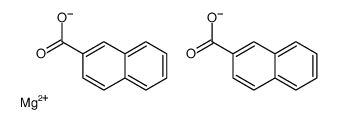Magnesium naphthenate
Modify Date: 2025-09-24 20:19:34

Magnesium naphthenate structure
|
Common Name | Magnesium naphthenate | ||
|---|---|---|---|---|
| CAS Number | 68424-71-5 | Molecular Weight | 366.64900 | |
| Density | N/A | Boiling Point | N/A | |
| Molecular Formula | C22H14MgO4 | Melting Point | > 100ºC | |
| MSDS | N/A | Flash Point | combustible | |
| Name | Magnesium di(2-naphthoate) |
|---|---|
| Synonym | More Synonyms |
| Melting Point | > 100ºC |
|---|---|
| Molecular Formula | C22H14MgO4 |
| Molecular Weight | 366.64900 |
| Flash Point | combustible |
| Exact Mass | 366.07400 |
| PSA | 80.26000 |
| LogP | 2.40660 |
|
Section 1: Product Identification Chemical Name:Magnesium naphthenate (3.5-8.0% Mg) CAS Registry Number:68424-71-5 Formula:Mg salt of napthenic acid EINECS Number:none Chemical Family:metal carboxylate Synonym:Naphthenic acid, magnesium salt
Section 2: Composition and Information on Ingredients IngredientCAS NumberPercentACGIH (TWA)OSHA (PEL) Title Compound68424-71-5100%no datano data Section 3: Hazards Identification Emergency Overview:No particular hazard associated with this material. Primary Routes of Exposure:Ingestion, skin Eye Contact:May causes slight to mild irritation of the eyes. Skin Contact:May causes slight to mild irritation of the skin. Inhalation:The material is a liquid. Inhalation is an unlikely source of exposure. Ingestion:No information on the physiological effects of ingestion. Acute Health Affects:May be irritating to skin, eyes and respiratory tract. Chronic Health Affects:No information available on long-term chronic effects. NTP:No IARC:No OSHA:No SECTION 4: First Aid Measures Immediately flush the eyes with copious amounts of water for at least 10-15 minutes. A victim may need Eye Exposure: assistance in keeping their eye lids open. Get immediate medical attention. Wash the affected area with soap and water. Remove contaminated clothes if necessary. Seek medical Skin Exposure: assistance if irritation persists. Remove the victim to fresh air. Closely monitor the victim for signs of respiratory problems, such as difficulty Inhalation: in breathing, coughing, wheezing, or pain. In such cases seek immediate medical assistance. Ingestion:Seek medical attention immediately. Keep the victim calm. Give the victim water (only if conscious). SECTION 5: Fire Fighting Measures Flash Point:not applicable Autoignition Temperature:none Explosion Limits:none Extinguishing Medium:carbon dioxide, dry powder or foam If involved in a fire, fire fighters should be equipped with a NIOSH approved positive pressure self-contained Special Fire Fighting Procedures: breathing apparatus and full protective clothing. Hazardous Combustion andIf involved in a fire this material may emit toxic organic fumes. Decomposion Products: Unusual Fire or Explosion Hazards: No unusual fire or explosion hazards. SECTION 6: Accidental Release Measures Spill and Leak Procedures:Small spills can be mixed with vermiculite or sodium carbonate and swept up. SECTION 7: Handling and Storage Handling and Storage:Store in a sealed container. Keep away from heat and moisture. SECTION 8: Exposure Controls and Personal Protection Eye Protection:Always wear approved safety glasses when handling a chemical substance in the laboratory. Skin Protection:Wear appropriate chemical resistant gloves and protective clothing. Ventilation:If possible, handle the material in an efficient fume hood. Respirator:No respirator required. Ventilation:If possible, handle the material in an efficient fume hood. Additional Protection:No additional protection required. SECTION 9: Physical and Chemical Properties Color and Form:dark viscous liq. Molecular Weight:not applicable Melting Point:no data Boiling Point:no data Vapor Pressure:not applicable Specific Gravity:no data Odor:none Solubility in Water:insoluble SECTION 10: Stability and Reactivity Stability:air and moisture stable solid Hazardous Polymerization:no hazardous polymerization Conditions to Avoid:none Incompatibility:oxidizing agents and halogens Decomposition Products:Carbon dioxide, carbon monoxide, organic vapors, and metal oxides and carbonates. SECTION 11: Toxicological Information RTECS Data:Oral (rat); LD50: 9140 mg/kg. Oral (mouse); LD50: 6450 mg/kg. Oral (rat); TDLo: 5490 mg/kg/30D-I. Carcinogenic Effects:No data available Mutagenic Effects:No data available Tetratogenic Effects:No data available SECTION 12: Ecological Information Ecological Information:No information available SECTION 13: Disposal Considerations Disposal:Dispose of according to local, state and federal regulations. SECTION 14: Transportation Shipping Name (CFR):Non-hazardous Hazard Class (CFR):NA Additional Hazard Class (CFR):NA Packaging Group (CFR):NA UN ID Number (CFR):NA Shipping Name (IATA):Non-hazardous Hazard Class (IATA):NA Additional Hazard Class (IATA):NA Packaging Group (IATA):NA UN ID Number (IATA):NA SECTION 15: Regulatory Information TSCA:Listed in the TSCA inventory. SARA (Title 313):Title compound not listed. Second Ingredient:none SECTION 16 - ADDITIONAL INFORMATION N/A |
CHEMICAL IDENTIFICATION
HEALTH HAZARD DATAACUTE TOXICITY DATA
|
| Risk Phrases | 36/37/38 |
|---|---|
| Safety Phrases | S26-S36-S37-S39 |
| MFCD00147520 |
| EINECS 270-317-9 |